About Seaweed and its Benefits
Seaweeds are simple marine plants. Seaweed don’t have roots, stalks, flowers, nor fruit. Instead, its body is composed of holdfast, thallus and lamina.
There are about 10 000 species of seaweed divided into three groups depending on the type of photosynthetic colours in their tissues:
- red (Dulce, Nori, Carrageen)
- green (Sea salad, Grass kelp)
- brown (Kombu, Kelp, Fucus species)
There is no poisonous seaweed in Swedish waters. What is important is to collect seaweed in clean water as it absorbs all its nutrients directly from the seawater. The seaweed for our products is collected mostly along the coast of Bohuslän. But we do travel to Greta’s place, Norway for specific seaweed species, such as Dulce and Laminaria hyperborea.
Seaweed is often referred to as a super-vegetable, as it contains several times more minerals and vitamins than land-grown vegetables (Ref). It is also used as a condiment, spice and as a healthy substitute of salt. We strongly believe in the many benefits seaweed brings to our diet (Ref). Seaweed contains high levels of vitamins A, B1, B12, C, D, riboflavin, niacin, folic acid, fatty acids (particularly omega-3 and omega-6, and at least 56 different minerals and trace elements such as calcium, iron, copper, iodine (ref). It also contains natural antioxidants and proteins (Ref). Even a small daily consumption of seaweed can fulfill the daily mineral requirements of an adult (Ref). Furthermore, approximately half of seaweed’s nutritional value is made of polysaccharides, which act as fibers in our digestive system.
